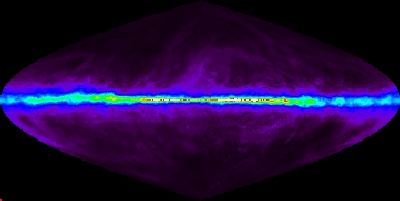Radio
| Wavelength range | m | > 0.1 |
| Frequency range | Hz | < 3×109 |
| Energy range | eV | < 10-5 |
Radio waves are at the long wavelength extreme of the electromagnetic spectrum. The wavelength of radio signals can range from 0.1 metres up to kilometres and beyond. The associated frequencies, being inversely proportional to the wavelength, can range anywhere from 3 GHz downward.
 |
|
All sky map at a wavelength of 21 cm. This emission comes from hydrogen atoms. The bright band across the image is the Milky Way with the galactic center in the middle of the image. |
ESA Missions
Their are no dedicated radio satellites. Radio astronomy is done from the ground by numerous radio observatories. The field of radio astronomy also makes use of interferometry where multiple radio dishes are used in parallel allowing to observe fainter and longer wavelength radio signals.
Sources of Radio emission include:
- The Sun: thermal emission from the hot gas plus peaks around sunspots
- Planets: electrons and charged particles trapped in the magnetosphere of planets emitting synchrotron radiation at radio wavelengths as they spiral around magnetic field lines
- Interstellar matter: line emission at a wavelength of 21 cm from neutral hydrogen gas
- Supernovae: two processes contribute to the radio emission: free electrons scattering of heavy ions (brehmsstrahlung) and electrons spiralling around magnetic field lines (synchrotron radiation)
- Quasars: bright galaxies at high redshift
